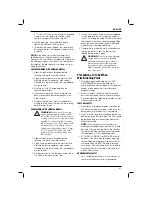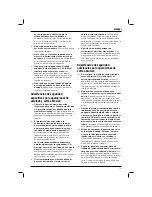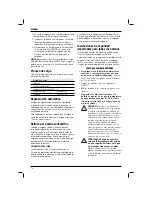
ENGLISH
61
3.17 mm (1/8") thick or less, place the threaded
clamp nut on the spindle so that the raised
centre is not against the wheel (Fig. 8B).
4. While depressing the spindle lock button,
tighten the clamp nut with a wrench.
5. To remove the wheel, depress the spindle lock
button and loosen the threaded clamp nut with
a wrench.
NOTE:
If the wheel spins after the clamp nut is
tightened, check the orientation of the threaded
clamp nut. If a thin wheel is installed with the pilot on
the clamp nut against the wheel, it will spin because
the height of the pilot prevents the clamp nut from
holding the wheel.
SURFACE GRINDING WITH GRINDING WHEELS
1. Allow the tool to reach full speed before
touching the tool to the work surface.
2. Apply minimum pressure to the work surface,
allowing the tool to operate at high speed.
Grinding rate is greatest when the tool operates
at high speed.
3. Maintain a 20˚ to 30˚ angle between the
tool and work surface.
4. Continuously move the tool in a forward and
back motion to avoid creating gouges in the
work surface.
5. Remove the tool from work surface before
turning tool off. Allow the tool to stop rotating
before laying it down.
EDGE GRINDING WITH GRINDING WHEELS
WARNING:
Wheels used for cutting
and edge grinding may break or kick
back if they bend or twist while the tool
is being used to do cut-off work or deep
grinding. To reduce the risk of serious
injury, limit the use of these wheels with
a standard Type 27 guard to shallow
cutting and notching [less than 13 mm
(1/2") in depth]. The open side of the
guard must be positioned away from
the operator.
1. Allow the tool to reach full speed before
touching the tool to the work surface.
2. Apply minimum pressure to the work surface,
allowing the tool to operate at high speed.
Grinding rate is greatest when the tool operates
at high speed.
3. Position yourself so that the open-underside of
the wheel is facing away from you.
4. Once a cut is begun and a notch is established
in the workpiece, do not change the angle of
the cut. Changing the angle will cause the wheel
to bend and may cause wheel breakage. Edge
grinding wheels are not designed to withstand
side pressures caused by bending.
5. Remove the tool from the work surface before
turning the tool off. Allow the tool to stop
rotating before laying it down.
WARNING:
Do not use edge grinding/
cutting wheels for surface grinding
applications because these wheels
are not designed for side pressures
encountered with surface grinding.
Wheel breakage and serious personal
injury may result.
Precautions To Take When
Wire Brushing Paint
1. Wire brushing of lead based paint is NOT
RECOMMENDED due to the difficulty of
controlling the contaminated dust. The greatest
danger of lead poisoning is to children and
pregnant women.
2. Since it is difficult to identify whether or not a
paint contains lead without a chemical analysis,
we recommend the following precautions when
wire brushing any paint:
PERSONAL SAFETY
1. No children or pregnant women should enter
the work area where the paint wire brushing is
being done until all clean up is completed.
2. A dust mask or respirator should be worn by all
persons entering the work area. The filter should
be replaced daily or whenever the wearer has
difficulty breathing.
NOTE:
Only those dust masks suitable for
working with lead paint dust and fumes should
be used. Ordinary painting masks do not offer
this protection. See your local hardware dealer
for the proper N.I.O.S.H. approved mask.
3. NO EATING, DRINKING or SMOKING should
be done in the work area to prevent ingesting
contaminated paint particles. Workers should
wash and clean up BEFORE eating, drinking
or smoking. Articles of food, drink, or smoking
should not be left in the work area where dust
would settle on them.
ENVIRONMENTAL SAFETY
1. Paint should be removed in such a manner as
to minimize the amount of dust generated.
















































